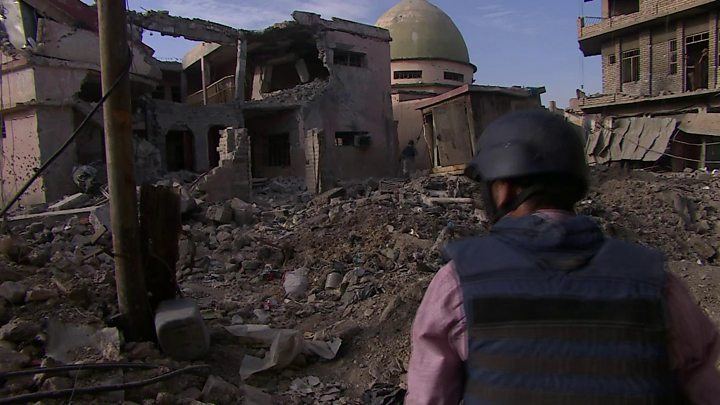
Iraqi Prime Minister Haider al-Abadi says the destruction of an ancient mosque in the city of Mosul is “an official declaration of defeat” by so-called Islamic State (IS).
Iraqi forces say IS blew up the Great Mosque of al-Nuri and its famous leaning minaret as jihadists battled to stop advancing pro-government troops.
IS said American aircraft had destroyed the complex, a claim denied by the US.
Aerial photographs show the complex largely destroyed.
The mosque, which was more than 800 years old, was where in July 2014 IS leader Abu Bakr al-Baghdadi commanded allegiance in his first and only public appearance following IS’ declaration days earlier of a “caliphate”.
The mosque’s destruction has brought widespread condemnation.
A senior US commander in Iraq said IS had destroyed “one of Mosul and Iraq’s great treasures”.
“This is a crime against the people of Mosul and all of Iraq, and is an example of why this brutal organisation must be annihilated,” Maj Gen Joseph Martin said.
- Why Mosul’s Great Mosque of al-Nuri mattered
- Battle for Mosul: The story so far
- WATCH: Mosul from above in 360 video
The Iraqi commander in charge of the offensive to retake Mosul said troops were within 50m (160ft) of the mosque when IS “committed another historical crime”.
Image copyright
Iraqi Joint Operation Command
The Iraqi military provided this image showing the destruction at the mosque compound
Thousands of Iraqi security forces, Kurdish Peshmerga fighters, Sunni Arab tribesmen and Shia militiamen, supported by US-led coalition warplanes and military advisers, are involved in the battle to retake the key city, which was launched on 17 October last year.
The government announced the full “liberation” of eastern Mosul in January but the west of the city has presented a more difficult challenge, with its narrow, winding streets.
On Tuesday Iraqi forces said they were releasing civilians previously trapped under IS control in the Old City.
In statement to state-run Iraqia TV, a military official said: “We have broken the siege of IS and allowed the civilians to leave. This is evidence that IS has lost control.”
Image copyright
EPA
The mosque’s famous leaning minaret, pictured in 2014, was covered with elaborate brickwork inspired by Iranian designs
The al-Nuri mosque dated back to 1172 and was named after a noble who fought against the early crusaders.
The leaning minaret was nicknamed “the hunchback”.
A month after IS forces overran Mosul in June 2014, Baghdadi gave a Friday sermon from the pulpit inside the mosque and spoke about the newly-proclaimed caliphate – a state governed in accordance with Islamic law, or Sharia, by God’s deputy on Earth, or caliph.
Image copyright
AFP
IS leader Abu Bakr al-Baghdadi proclaimed a “caliphate” in the mosque
On Sunday, commanders announced the start of the “final chapter” of the offensive, with Iraq’s counter-terrorism service, army and federal police attacking the Old City from all directions.
The army said it believed there were no more than 300 militants left in Mosul, compared with almost 6,000 at the start of the offensive in October.
Earlier this week aircraft dropped leaflets urging civilians to avoid open spaces and to take any opportunity to escape.
The UN has warned that IS may be holding more than 100,000 people in Mosul as human shields.
Why would IS blow up the Nuri mosque? By Paul Adams, BBC News World Affairs correspondent
It is Mosul’s most famous Sunni mosque, named after the Muslim leader, Nur al-Din Mahmoud Zangi, famous for waging jihad against Christian crusaders.
And it is where the leader of Islamic State, Abu Bakr al-Baghdadi, made his one and only public appearance, shortly after his group declared a caliphate in Iraq and Syria.
But IS fighters have shown scant regard for history or culture in the three years since their lightning advance across northern Iraq.
Reports that they rigged the Nuri mosque with explosives have been circulating since Iraqi government forces began their effort to take back the city nine months ago.
Destruction of the mosque, most observers assumed, would mark the group’s final act of angry defiance before finally losing their grip on Mosul.
IS claims that the mosque was destroyed by a US airstrike. This seems unlikely but such is the savage nature of the struggle for control of Mosul that it’s fair to say that preserving the city’s cultural and religious heritage has not been a high priority for anyone involved.
Battle for Mosul: Destruction of al-Nuri mosque ‘shows IS defeated’}

